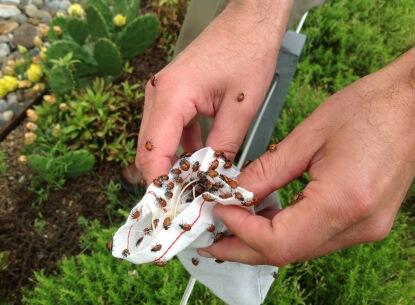
May 24, 2013
Lady Bug, Lady Bug, Eat Up
Share this story
Early morning raindrops, hanging on the leaves of Virginia Commonwealth University’s Pollak Building’s rooftop garden, acted as welcomed drinks of water for 1,500 lady bugs as they were introduced to their new home.
The lady bugs, also known as lady beetles or hippodamia convergens, were summoned to help address a pest problem happening in the garden. Lace bugs had invaded the green roof and were slowly eating their way through the perimeter plants.
Before the problem got worse, Paul Thrift, superintendent of grounds with facilities management, enlisted the help of Scotty Guinn, sustainable landscape design specialist, to help develop a green solution to oust the invasive pests.
“We wanted to minimize the toxicity of insecticides on our environment,” said Thrift.
“It’s the opposite of a green roof to start adding chemicals to it and then have the runoff end up in the water system,” added Guinn.
So it was decided that beneficial insects, bugs that naturally prey on plant-eating insects, would be introduced to the garden to help create a more complete ecosystem.
“This is a first for VCU,” said Thrift. “It’s an integrative pest management approach. The release of beneficial insects is the least invasive thing we can do to bring the pest population under control, rather than resorting to a traditional chemical right out of the gate.”
Despite their childish appeal, lady bugs are actually voracious predators that feed on various aphids, beetle larvae, lace bugs and many other soft-bodied insects and eggs.
Early next week, 1,000 green lacewing insects, not to be confused with the invasive lace bugs, will join the lady bugs in the rooftop garden.
The Pollak Building green roof first came to life in October of 2011. Students from the VCU School of the Arts Department of Interior Design spent a day planting perennials, grasses and succulents as part of a $20,000 project supported by the Monroe Park Student Government Association in conjunction with the Office of Sustainability and Facilities Management.
Less than a year later, the roof was recognized by the Virginia Sustainable Building Network's 2012 Green Innovation Awards as the winner of the Best Green Institutional Project - Special Commendation.
The Inger and Walter Rice Center for Environmental Life Sciences houses the first green roof ever built at VCU.
Subscribe for free to the weekly VCU News email newsletter at http://newsletter.news.vcu.edu/ and receive a selection of stories, videos, photos, news clips and event listings in your inbox every Thursday.
Subscribe to VCU News
Subscribe to VCU News at newsletter.vcu.edu and receive a selection of stories, videos, photos, news clips and event listings in your inbox.





